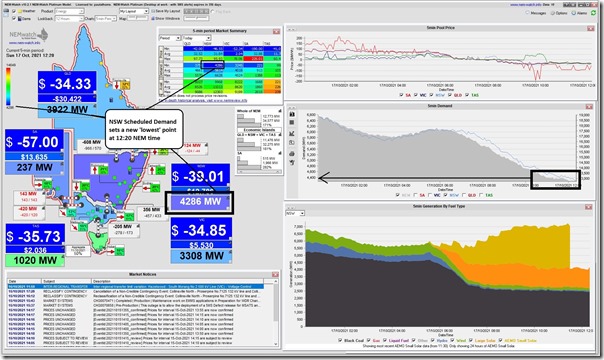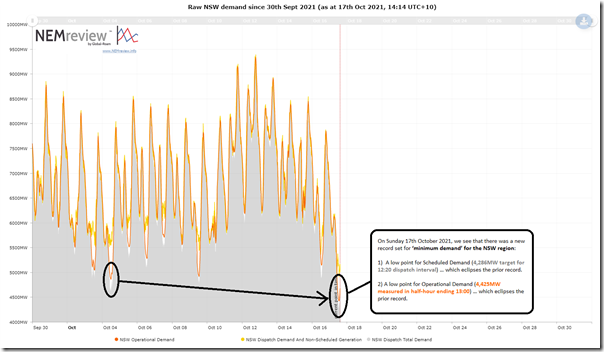As noted in the earlier ‘part 1’ article, we eclipsed the prior record for minimum demand in the NSW region in the 10:45 dispatch interval.
Over the 3:40 hours that followed, the Scheduled Demand in NSW remained submerged under that prior level through until the 14:25 dispatch interval (NEM Time) at which point demand had climbed out of the hole dug by the insatiable growth of rooftop PV.
Remembering that there are some gory details in terms of how demand is measured (and why) …
(A) Lowest point for Scheduled Demand
The lowest point for the ‘Total Demand’ measure published by AEMO (representing ‘Market Demand’ or ‘Scheduled Demand‘) occurred in the 12:20 dispatch interval, and was captured in this snapshot from the NEMwatch software at the time:
A low point for Scheduled Demand (4,286MW target for 12:20 dispatch interval) … which eclipses the prior record set on Monday 4th October 2021.
In contrast to yesterday in QLD, we see that the 5-minute trading prices are only just below $0/MWh (i.e. in the ‘negative LGC’ price range):
1) so we can see plenty of Large Solar production in NSW to accompany the rooftop PV production as well.
2) have not checked to see why wind generation is low … might be to do with low wind, or constraints, or perhaps because of bidding.
(B) Lowest point for Operational Demand
In recent years, AEMO increasingly likes to refer to ‘Operational Demand’ (which you could also think of as ‘Grid Demand’ that they can easily see in real time).
Using this Trend Query in our NEMreview v7 software, here’s a look at three different measures of demand published by AEMO for the NSW region over the past few weeks, including the date of the prior low point:
As noted above, there was a low point for Operational Demand (4,425MW measured in half-hour ending 13:00) … which eclipses the prior record. I assume AEMO will be along later to confirm this?
—
You’ll find more details about ‘minimum demand’ of interest in this ‘part 4’ article (still coming…).




We knew that the intermittent providers can displace coal but they can’t replace it. SA was importing coal power until after breakfast and it is importing now, thanks to the efforts of the much maligned brown coalers that are running over 90% of capacity while the wind is delivering 2% of Victorian generation.